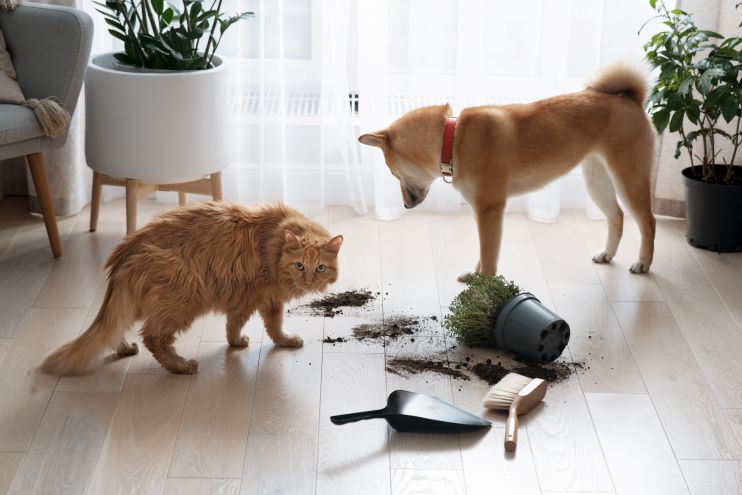A safe and stimulating environment is vital for the overall well-being of your pets. Like us, pets thrive when their physical and mental needs are met, which leads to a happier, healthier, and more well-adjusted companion. From dogs to cats and beyond, every pet deserves a space that supports their natural behaviors and keeps them out of harm’s way.
Let’s dive into how you can ensure your home is the perfect place for your pets to live, play, and relax!
Why a Safe Environment is Crucial for Pets
Pets, whether dogs, cats, or other companions, rely on their environment to meet their basic needs. Just as humans need a balanced lifestyle with mental stimulation and physical exercise, so do animals. Without these essentials, pets may become bored, anxious, or destructive, which can lead to behavioral problems or health issues.
For dogs, a lack of physical exercise can result in restlessness or even obesity. Cats, on the other hand, might resort to scratching furniture or engaging in other unwanted behaviors if their instincts aren’t satisfied. Thus, providing an environment that caters to both their physical and mental needs is critical.
How to Keep Your Dog Engaged and Active
Dogs, being naturally active animals, need ample opportunities for exercise and mental stimulation. Here’s how you can create an ideal space for them:
- Daily Exercise and Playtime: Regular walks, fetch games, and free runs are essential to burn off your dog’s energy. Make sure they get at least 30 minutes to an hour of physical activity each day, depending on their breed and age.
- Interactive Toys: Use puzzle toys, treat dispensers, and chew toys to keep your dog mentally engaged. Dogs love the challenge of figuring out how to get a treat out of a puzzle toy, and it helps prevent boredom when you’re not around.
- Safe Spaces: Designate areas in your home where your dog can relax. Crates or cozy corners with their bed provide them a space to retreat when they feel overwhelmed or need rest.
By incorporating these elements, your dog’s environment will foster physical health and mental sharpness.
Creating a Stimulating Space for Your Cat
Cats may not need as much physical exercise as dogs, but they have their own unique requirements for mental stimulation and engagement. Cats are instinctive climbers and hunters, so providing opportunities for these behaviors is important. Here’s how to make sure your cat stays happy:
- Vertical Spaces: Cats love to climb and survey their territory from above. Install cat trees, shelves, or perches near windows, allowing them to indulge their climbing instincts while staying safe indoors.
- Scratching Posts: Cats need to scratch to keep their claws healthy and to mark their territory. Make sure they have access to scratching posts around the house to prevent them from ruining furniture.
- Interactive Toys and Games: Engage your cat with toys that mimic prey, such as feather wands or laser pointers. Interactive toys that require your cat to chase or pounce help keep their hunting instincts sharp and reduce boredom.
- Safe Hideaways: Just like dogs, cats need a place to feel secure. Provide cozy beds, tunnels, or even a quiet corner where they can retreat when they need some alone time.
By giving your cat access to vertical spaces, safe hiding spots, and interactive play options, you’ll create an environment that satisfies their natural instincts and promotes well-being.
Essential Safety Tips for Your Pet’s Environment
While creating a stimulating environment for your pets is important, ensuring that it’s safe is equally critical. Many household items or plants can pose hazards to your furry friends if you’re not careful. Here are some key safety tips to keep in mind:
- Remove Toxic Plants: Some common houseplants, such as lilies, aloe vera, and philodendrons, are toxic to both cats and dogs. Make sure to research which plants are pet-safe or keep toxic plants out of reach.
- Secure Electrical Cords: Pets, especially puppies and kittens, may be tempted to chew on electrical cords. Make sure all cords are securely fastened or tucked away to prevent shocks or choking hazards.
- Watch for Small Objects: Items like buttons, coins, or toys with small parts can be swallowed by pets. Keep these out of reach, and ensure any toys given to your pets are appropriately sized and safe.
- Avoid Harmful Chemicals: Cleaning products, pesticides, and medications should always be stored out of your pet’s reach. Even seemingly harmless items like chocolate, grapes, or certain essential oils can be toxic to pets.
By removing these hazards, you’re helping to prevent accidents and creating a safer home for your pets.
Why Pets Need Safe Spaces to Retreat To
Pets, like humans, can become overwhelmed by their surroundings. This is why having a designated safe space where your pet can retreat is so important. For dogs, this might mean a crate or a quiet corner in the house, while cats may prefer high perches or cozy, enclosed beds. Here’s why these spaces are crucial:
- Helps Manage Anxiety: Safe spaces provide a sense of security for pets, particularly during stressful times such as thunderstorms, fireworks, or when you have visitors over.
- Promotes Rest and Relaxation: Just like people, pets need time to wind down. A quiet, cozy area gives them a place to relax without being disturbed.
- Encourages Independence: Providing a safe space for your pet also fosters independence. They learn to self-soothe and retreat when they need to recharge.
These safe spaces help to balance a stimulating environment, giving pets the option to take a break when they feel overwhelmed.
Final Thoughts on Building the Perfect Pet Environment
Creating a pet-friendly environment that is both safe and stimulating requires careful consideration of your pet’s unique needs. By focusing on providing physical exercise, mental stimulation, and a secure space, you’re setting your pet up for a happier and healthier life. Remember, the effort you put into designing this environment will not only improve your pet’s well-being but also strengthen the bond you share with them.
Whether you have an energetic dog or a curious cat, making your home both engaging and safe will allow your pets to thrive.
FAQs
How much exercise does my dog need every day?
Dogs generally need at least 30 minutes to an hour of exercise per day, but this can vary based on breed, age, and health.
What types of toys are best for keeping my dog mentally stimulated?
Puzzle toys, treat dispensers, and interactive chew toys are great for keeping dogs engaged and preventing boredom.
How can I make my home safer for my pet?
Start by removing toxic plants, securing electrical cords, and keeping small objects or harmful chemicals out of reach.
Why do cats need vertical spaces like shelves or cat trees?
Cats are natural climbers and love to observe their surroundings from above. Vertical spaces help them exercise and fulfill their instincts.
What should I do if my pet shows signs of anxiety or stress?
Ensure they have access to a quiet, safe space where they can retreat, and consider using calming aids like pheromone diffusers or anxiety vests.
Is it okay to leave my dog in a crate while I’m at work?
Crating can be a safe option as long as it is not for too long and your dog is comfortable with it. Make sure the crate is large enough for them to move around, and leave toys to keep them occupied.
Inbound Links:
Outbound Links:




